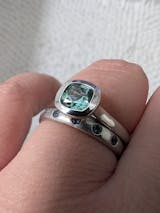Ruby Gemstone Information
Rubies, with an hardness of 9 on the Moh's scale, topped only by moissanites and diamonds, are one of the most valuable and wearable of all gemstones and an excellent choice for engagement and wedding rings. Rubies & Sapphires are closely related. They are both members of the corundum family. These two gems have the same mineral composition but were named for their striking colors. Ruby is the name for red corundum and all the other colors of corundum are named sapphire. But ruby is in fact much rarer than sapphire. The world demand for ruby far exceeds the supply and therefore increases it's price. The most desirable rubies are deep red, sometimes called pigeon's blood.
Ruby is the birthstone of people born in July.

Major sources for rubies:
While ruby producing countries include Thailand, Cambodia, Sri Lanka, Kenya, Afghanistan, India, Pakistan, Tanzania and Madagascar, almost 90% of the world’s production of Ruby is from Myanmar. Due to human rights abuses in this country, the United States government has banned imports from Myanmar, making on-hand supply of Ruby limited. The limited supply did skyrocket the price of rubies.
I purchase rubies from suppliers who guarantee that their stones are "non-Burmese covered articles" in that they were not mined in or extracted from Burma, or were imported into the United States prior to September 27, 2008.

Corinne - Curved Contoured Wedding Ring With Rubies
Another ethical alternative are lab created rubies. Duplicating nature's environment, created rubies are grown over time with identical physical, chemical and optical properties to those found in nature. They are synthetic, but by no means fake. They are real rubies grown in a laboratory. Unlike natural genuine mined rubies, which can be highly included, lab created rubies have no inclusions. Lab created rubies provide top quality and color for a fraction of the price of natural rubies. Plus there was no mining and earth destruction involved in creating theses gems.

Ruby grading:
Like most colored gemstones rubies are graded on a letter scale.

| Commercial |
Commercial quality; variation in color; included |
|
| A |
Medium pinkish red; slightly included; good cut; good polish |
|
| AA |
Medium dark pinkish red; eye clean; good brilliance; good cut; good polish |
|
| AAA |
Medium dark pinkish red to red; eye clean; good brilliance; excellent cut; good polish |
|
| B |
Light pinkish red; included; good cut; good polish |
|
| Bright Fine |
Medium dark pinkish red; eye clean; excellent brilliance; excellent machine cut |
|
| Top Burmese Fine |
Dark slightly purplish red; eye clean; excellent brilliance; excellent machine cut |
|
Not all grades are available for all sizes and shapes.

Enhancements:
Most rubies have been heated to improve their color and sometimes also clarity. Heating is a permanent enhancement, as lasting as the gemstone itself. Heated rubies can be re-cut and re-polished if needed without affecting it's color hue.
There are also un-enhanced natural rubies and sapphires available but they are rare and fetch high prices.
Beware of fracture filled or also called composite rubies. This technique is used to improve the appearance of rubies of good color, primarily from Madagascar, that are disfigured by fissures or surface cracks. These previously unsaleable gems could be repaired using heat treatment with lead glass. These fracture-filled rubies sell at a fraction of the cost of untreated rubies of similar color. However, there is no regulation of how much lead glass can be in such a ruby. You may in fact end up with a stone that's mostly glass and very little actual ruby mineral. The treatment is highly unstable, resulting in stones that can be easily damaged beyond repair. Jewelry with these stones can't easily be repaired as they can't tolerate heat nor certain chemicals like the pickling acid used to clean precious metal after soldering. The Gemological Institute of America Inc (GIA) advised against this treatment. This treatment, like all enhancements, has to be disclosed to the consumer.
Care for your ruby:
Rubies are rated “excellent” for everyday wear. Due to their Moh's hardness of 9 they are very scratch resistant but can be scratched by moissanites and diamonds. Avoid exposure to heat and contact with chemicals.
Clean rubies regularly as any soap scum residue can quickly make them look dull and lifeless. To clean, gently scrub with a soft toothbrush and a solution of mild dish soap and warm water, rinse well and dry with a lint free cloth. Or clean in an at-home ultrasonic unit. More jewelry care info is available here.

Shop for Ruby engagement rings or wedding rings on my site.





















